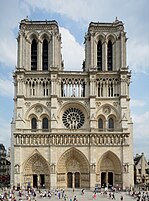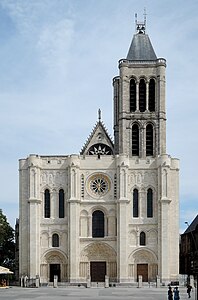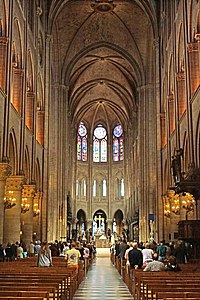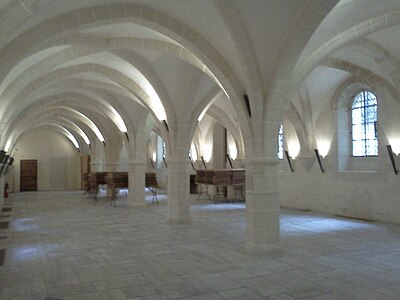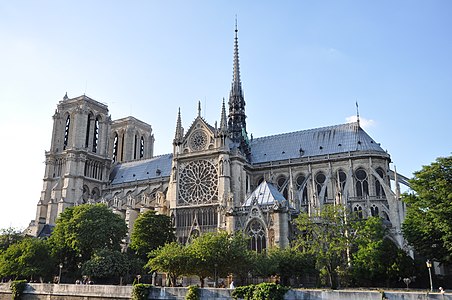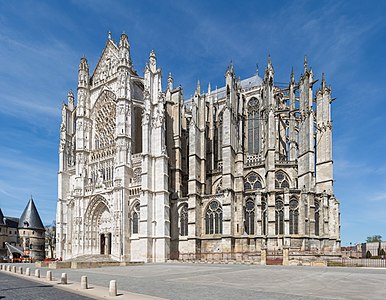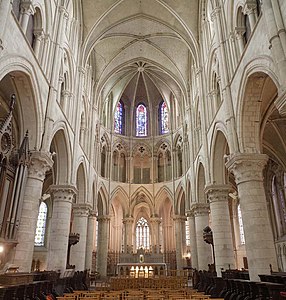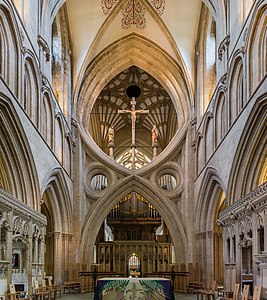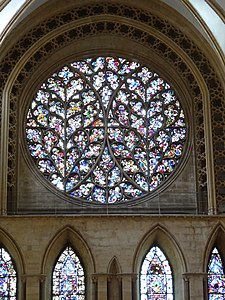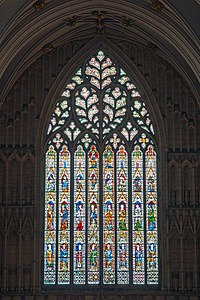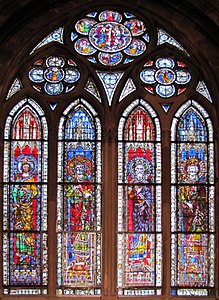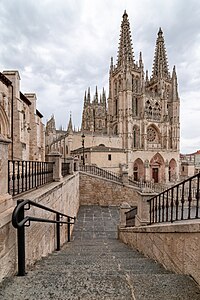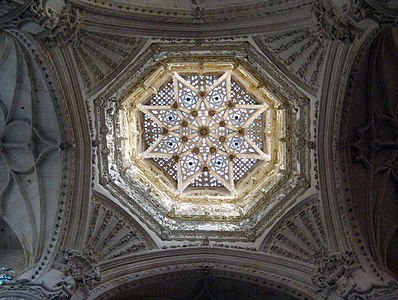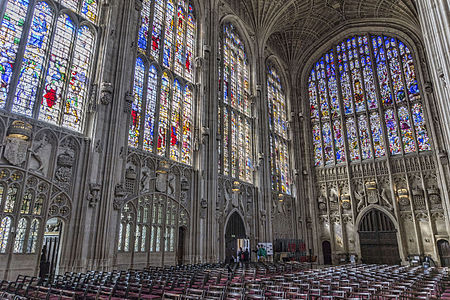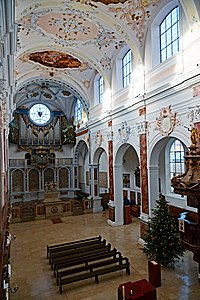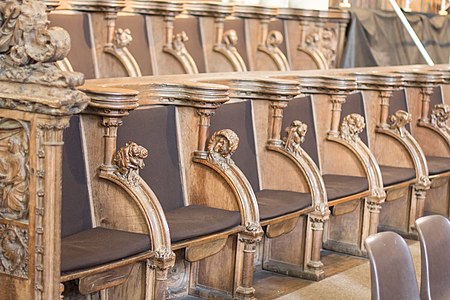Gothic cathedrals and churches
Top: Notre-Dame de Paris; Salisbury Cathedral: Centre: buttresses of Cologne Cathedral, façade statuary of Chartres Cathedral; Bottom: windows of Sainte-Chapelle, Paris | |
| Years active | 12th–16th centuries |
|---|---|
Gothic cathedrals and churches are religious buildings created in Europe between the mid-12th century and the beginning of the 16th century. The cathedrals are notable particularly for their great height and their extensive use of stained glass to fill the interiors with light. They were the tallest and largest buildings of their time and the most prominent examples of Gothic architecture. The appearance of the Gothic cathedral was not only a revolution in architecture; it also introduced new forms in decoration, sculpture, and art.
Cathedrals were by definition churches where a bishop presided. Abbeys were the churches attached to monasteries. Many smaller parish churches were also built in the Gothic style. The appearance of the great cathedrals in the 12th century was a response to the dramatic increase of population and wealth in some parts of Europe and the need for larger and more imposing buildings. Technical advances, such as innovative uses of the pointed arch, rib vault and flying buttress, allowed the churches and cathedral to become much taller and stronger with larger windows and more light.[1]
The Gothic style first appeared in France at the
The style quickly appeared in England, where it was called simply "The French style". The Choir of Canterbury Cathedral was destroyed by fire and was rebuilt by a French master builder from Sens, William of Sens, between 1174 and 1184. Other elements of the style were imported from Caen in Normandy by French Norman architects, who also brought finely-cut stones from Normandy for their construction.[4]
Renaissance cathedrals and churches gradually replaced Gothic cathedrals, and the original cathedrals, such as Notre Dame, experienced many modifications or fell into ruin (in the Low Countries, however, the Brabantine Gothic remained until far in the 17th century). However, in the mid-19th century, in large part due to the novel Notre Dame de Paris, better known in English as The Hunchback of Notre-Dame, by Victor Hugo, there was a new wave of interest in the Gothic cathedral. Many Gothic cathedrals and churches were restored, with greater or lesser accuracy.
Name
The term
The word church stems from the word chirche from Middle English. People are not sure of where this word came from but scholars think it is derived from the Greek word kuriakon. Kuriakon comes from another word kuriakos which means "of, or belonging to, a lord, master,"[6]
At its time, Gothic architecture was called "The French Style." The term "Gothic" was a negative term invented in the late Renaissance by its critics, including the art historian and architect Giorgio Vasari. They considered the style barbaric, the opposite of the new Renaissance style, which they favored.
Early Gothic – France (mid-12th century)
Abbot Suger and St Denis Basilica
The Gothic style first appeared in France in the mid-12th century in an
Suger, with the full support of the King, decided to enlarge the church and reconstruct it on a new model.[7] His first modification was a new west façade, inspired in part by new churches in Normandy, with two towers and three deep portals. Each of the portals had a tympanum of sculpture, telling a Biblical or inspiring story. The tympana installed by Sugar depicted the Last Judgement over the main door and the martyrdom of Saint Denis over the other door. The tympana over the east portals became a characteristic feature of later Gothic cathedrals.[8] When the new façade was complete, Suger turned his attention to the choir and the ambulatory in the west of the church.
Suger was also a scholar of the philosophy of Plato, and he believed that light was a way through which the faithful could be elevated from the material to the immaterial and the divine. The ambulatory of the old church was very dark, since Romanesque architecture, with barrel vaults, required thick walls and supporting walls between the small chapels. Suger decided to use a new form of vault, the rib vault, with pointed arches, which was higher and stronger. This allowed him to remove the walls between the chapels, and opened the space for seventy stained glass windows in the choir, filling the church with light.[8]
The new structure was finished and dedicated on 11 June 1144, in the presence of the King. The choir and west front of the Abbey of Saint-Denis both became the prototypes for other buildings in the royal domain of northern France and in the Duchy of Normandy. Through the rule of the Angevin dynasty, the new style was introduced to England and spread throughout France, the Low Countries, Germany, Spain, northern Italy and Sicily. The combination of innovations made Saint-Denis the first important example of Gothic architecture; The church was heavily modified over the following centuries, but the ambulatory and some other original elements remain.[9][page needed]
-
The Gothic ambulatory of the Basilica of Saint-Denis (1140–1144)
-
The west façade of the Basilica of Saint-Denis, after restoration. It originally had two towers.(1140–1144)
-
Detail from the 12th-century Life of Christ window
The new features of Saint-Denis were quickly adapted in the construction of new cathedrals in the Ile-de-France. These included
- Noyon Cathedral replaced a Romanesque cathedral which burned in 1131. The Bishop of Noyon, Baudouin, used the choir of Saint Denis as his direct model. He used the same masons as Suger, and much of the ornamentation is identical with Saint-Denis. Like many early Gothic churches, the interior has both round and pointed arches, and it has some peculiar Germanic features, such as transepts with rounded ends.
- Abelard and Thomas Becket, who came there in 1164 to appeal to the Pope for support against Henry II of England. It was begun as a Romanesque cathedral, but as the walls were rising, the design was changed to Gothic and the proposed groin vaults replaced by rib vaults. It was completed soon after Saint Denis, and is considered the first Gothic Cathedral in France.[3]
- Notre Dame de Paris. A major fire in 1504 destroyed the upper vaulting of the original cathedral, and now only the apse, the west façade, and the tower have their original appearance; The exterior is now distinctly flamboyant Gothic.[10]
- Laon Cathedral was begun in about 1160. Like many early Gothic cathedrals, it retained some romanesque features, including tribunes over the side aisles, use of both round and pointed arches, and a two-story chapel on each arm of the transept. Like most early Gothic churches, it was not exceptionally high, but it was exceptionally long, with eleven bays in the nave, and ten in the choir. Because it was not high, it was possible to build a square tower over the crossing of the transept, in addition to four shorter towers on the corners, each with long lancet openings. One curious feature is the sixteen life-sized sculpted oxen on towers, each under its own canopy, symbolizing the animals which hauled the stones to the site.[10]
-
Noyon Cathedral (begun about 1150)
-
Nave of Sens Cathedral (1140–1164)
-
Senlis Cathedral (1153–91): The original 12th-century tower was crowned with an octagonal tower and spire in the 13th century.
-
Façade of Laon Cathedral (begun 1160)
- Notre Dame de Paris begun in 1163 by the archbishop Maurice de Sully, was the largest and highest of the new French cathedrals. The nave was 122 meters long and the vaulted ceiling was 35 meters high, twelve meters higher than Laon Cathedral. It used the older six-part rib vault in the ceiling, but replaced the alternating pillars and columns of earlier cathedrals with a single type of pillar, creating greater harmony. It made innovative use of flying buttress to counterbalance the weight of the higher vaults, so the walls could be thinner and have more windows. It had four levels, like the earlier cathedrals, but the old triforium was replaced by small rose windows. Unlike Laon Cathedral, the façade of Notre Dame, with its two towers, expressed a remarkable calm and harmony. Notre-Dame was modified in the later Gothic period, with the addition of the rose windows in the transepts (1250–1260) and double flying buttresses.[11]
-
The façade of Notre-Dame de Paris (begun 1163)
-
With flèche
-
Nave of Notre-Dame de Paris, 122 meters long
Early Gothic – England
Gothic elements, often called "The French style". soon appeared in English cathedrals and abbeys. While English cathedrals tended to follow the French style, they had a few special characteristics of their own. Unlike French cathedrals, they tended toward great length rather than great height. They also made extensive use of Purbeck Marble for columns, floors and wall panels, which added colour and reflection to the interiors. The early English style lasted from the late 12th century to the mid-14th century.[12]
- Canterbury Cathedral (Early Gothic portion – 1174–85) One of the earliest to use Gothic features in the French way was Canterbury Cathedral. Following a fire in 1174 which destroyed much of the choir, a French master builder, William of Sens, who probably had participated in the construction of Sens Cathedral, was selected to conduct the reconstruction. It was rebuilt between 1174 and 1184. William of Sens himself fell fifty feet from the scaffolding and was seriously injured, and had to return to France, where he died in 1180. It was completed by an English builder, William the Englishman.[13] While the choir is not as high as some French cathedrals, it makes up for the difference by its dramatic length. The choir is 180 ft (55 m) long and 71 ft (22 m) high.
The nave and much of the rest of the cathedral were rebuilt into the
-
Canterbury Cathedral (1174–1834) The exterior was largely rebuilt into the perpendicular style in the 14th and 15th centuries.
-
Choir of Canterbury Cathedral by William of Sens (1174–84). (The lower arcades and stalls are a later addition)
- rose windows, called the Bishops's Eye and the Dean's Eye, were added at about the same time. The original cathedral had two towers on the west façade, and then a central tower was built in the 14th century, topped by a wooden spire, which made it the tallest structure in the world for two hundred years. The other two towers were also given spires and raised in height. The great spire fell during a windstorm and was not replaced.
-
Lincoln Cathedral (1192–1225)
-
The elaborate vaults of the nave were added in the late 12th and 13th century.
- Salisbury Cathedral was begun in 1220. Its chief patron was William Longespée, the 3rd Earl of Salisbury, who was recognized as a son by Henry II of France. He was sent by the King on missions to France, and was prisoner there for a time, and was familiar with the new French style. The king provided timber for the cathedral from Ireland and from his estates. Longsword was buried in the cathedral in 1226. The body of the cathedral was completed by September 1258.[14] The west front, cloisters and chapter house were complete by about 1275.
The most famous feature of Salisbury Cathedral was added later, between 1300 and 1320, when it was given the tallest spire in England – 123 m (404 ft). The cathedral received another innovation in 1386: the first clock in England that struck the hours.[15]
-
The west front of Salisbury Cathedral (1220–1258). (Spire from 1300 to 1320)
-
Nave of Salisbury Cathedral (1220–1258)
Cistercian Gothic (12th century)
Many of the abbey churches of the Cistercian monastic order, particularly the later churches, had a unique austere form of Gothic. The order, founded in 1098 by an English monk,
- Trappist monastery.[17]
- Saint Bernard of Clairvaux, It gradually became the mother church of the growing order. By the time of the death of Saint Bernard, there were 338 Cistercian Abbeys, including 68 founded directly by Saint Bernard. They were found in nearly every part of Europe, from Sweden and Scotland south to Portugal, and to the eastern end of the Mediterranean. But of the original Gothic abbey of Clairvaux, only a vaulted stone storehouse remains.[17]
- Fontenay Abbeyin Burgundy was founded by Saint Bernard of Clairvaux in 1118, because he felt the monks of Clairvaux were not following the rules strictly enough. It was completed by 1200, and could shelter three hundred monks. Much of the original Abbey still stands. It was an early hybrid of Romanesque and Gothic: the barrel vaults are slightly pointed, rather than rounded, as are the windows.
- Saint Bernard of Clairvaux, the founder of the Cistercians, as their mother church in England. It was closed in 1538 by Henry VIII and fell into ruin, but the chancel and chapel and transept are still standing.[18]
Other examples of Cistercian Gothic can be found across Europe, and several are UNESCO World Heritage Sites. These include
The early Gothic style was also used in the reconstruction of several English Benedictine
-
Nave ofFontenay Abbeychurch, with pointed barrel vaults (1147).
-
Cellar of Clairvaux Abbey, Dijon (12–13th century)
-
Library ofCiteaux Abbey(13th century)
-
The "Paradise" or Narthex ofMaulbronn Abbey, Germany (late 13th century)
-
Cloister ofPoblet Monastery, Spain (founded 1153)
-
Ruins of Rievaulx Abbey (begun 1132)
-
Whitby Abbey (1220s)
High Gothic and Rayonnant Gothic – France (Thirteenth Century)
In France, the last part of the long reign of King
The early thirteenth-century cathedral style in France is often called
- Chartres Cathedral was constructed following the destruction by fire of the Romanesque cathedral in 1194, which left only the crypt, royal total an apse intact. It was rapidly reconstructed, and was largely finished by 1221.[24] It surpassed Notre Dame de Paris both in length (130.2 meters) and height (36 meters). It had an immense transept which had its own collateral chapels. The choir was extended by a double disambulatory with three radiating chapels. Chartres has a number of innovative features. The traditional level of tribunes on both sides of the nave were removed, thanks to the strength and reach of the flying buttresses, reducing the number of levels from four to three. This made room for a row of large windows, the same height as the ground-floor arcades, bringing much more light into the church, and a greater sensation of harmony. Another innovation was the use of the simpler but stronger quadripartite rib vault instead of the six-part vaults of Notre Dame, which allowed greater height and a simpler arrangement of columns and pillars on the ground floor. The cathedral was originally planned to have seven towers, but in the end had only two, from different periods.[22] Another feature of Chartres was the use of walls painted white or in different colours. As of 2020[update], after the walls had been cleaned of soot and dirt, these colours are in the process of being restored or recreated, a measure that has drawn some criticism.[25]
-
Chartres Cathedral (1194–1221), showing the flying buttresses.
-
The three levels of the nave of Chartres Cathedral, with larger windows in the clerestory on the top level.
-
South rose window of Chartres Cathedral.
- rose windows were added to the north and south transepts. Longer and stronger flying buttresses were added to support the choir, which allowed thinner walls, and larger windows were added to the clerestory. The two towers were completed in 1245.[26]
-
Notre-Dame, showing south rose window and extended flying buttresses around the choir (about 1260)
-
The north rose window of Notre Dame (about 1260)
- Amiens Cathedral was begun in 1220. Its builder, the Bishop Evrard de Fouilloy, had the ambition of making it the largest cathedral in France, and he succeeded. Its nave is 145 meters long and 70 meters wide at the transept. Its elevation copied Chartres in having just three, not four levels, but the plan was very different. At Amiens the arcades on the ground floor are a full eighteen meters high, equaling the combined height of the triforium and clerestory above. Amiens adopted the system of stained glass windows in chassis that was used at Reims, but went a step further. The high clerestory windows in the nave are composed of four lancet windows topped by two rosettes, while those in the transept have as many as eight lancets in single window.[27]
-
Amiens Cathedral (begun 1220)
-
Choir and altar of Amiens Cathedral
- Passion of Christ. It is composed of a lower chapel, used by the Palace and the Court, and an upper chapel, where the relics were kept, where the walls are filled with an exceptional array of stained glass windows.[28]
-
Exterior of Sainte-Chapelle (1241–48)
-
Upper chapel of Sainte-Chapelle (1241–48)
-
The Rayonnant rose window of Sainte-Chapelle (1241–48)
- First World War, but restored and reconsecrated in 1937. Like Chartres, the elevation has just three levels, giving more space for windows. The traditional tympanum on the façade was replaced by a large rose window, while the sculpture usually on the tympanum was moved to the inside of the façade. Another innovation at the Reims was the placement of each stained glass windows in a large separate chassis, or frame, rather than directly into the wall, which allowed much more complex patterns. Another innovation was the placement of statues of angels sheltered in the pinnacles atop the flying buttresses. In all, Reims has more than 2300 statues in its decoration.[29]
-
Façade of Reims Cathedral (1211 to the 16th century)
-
Western rose window
- Beauvais Cathedral had an unfortunate history. After a fire in 1225 destroyed the old cathedral, Bishop Milon de Nanteuil proposed to construct the tallest cathedral of all. The choir, forty meters high, was finished in 1272, but collapsed in 1284. It was rebuilt with reinforced pillar vaults with additional rib in the 14th century. The transept was completed in the 1560s and was capped with a stone and wood spire 150 meters high. Unfortunately, the spire collapsed in 1573, and the cathedral was left unfinished, with only the choir and transept completed.[30]
-
The unfinished Beauvais Cathedral (1225–1272)
-
Choir of Beauvais Cathedral
French regional Gothic – Normandy
At the beginning of the 13th century,
- Benedictine Abbey, founded in 1056 and confirmed by William the Conqueror. The choir was rebuilt with rib vaults beginning in 1098, about the same time as Durham Cathedral and the Basilica of Saint-Denis, making them among the earliest Gothic vaults in Europe. The church was destroyed by the retreating Germans in 1944, and later completely rebuilt in the original Romanesque style.[1]
- Lisieux Cathedral begun in 1170, was one of the first Norman cathedrals to be built with Gothic features.[31]
- Bayeux Cathedral (1060–1070). The Romanesque cathedral nave and choir were rebuilt into the Gothic style.
- Coutances Cathedral was remade into Gothic beginning about 1220. Its most original feature is the octagonal lantern on the crossing of the transept, resting on pendentive vaults, decorated with ornamental ribs, and surrounded by sixteen bays and sixteen lancet windows.[32]
- Rouen Cathedral (begun 1185). The Archbishop of Rouen, Gautier de Coutances, began to reconstruct the Romanesque interior of the newly built Rouen Cathedral, The nave retained the early Gothic plan of four levels, but the tribunes were deliberately left unfinished, and the newer choir merged the four levels into three. The ambulatory was surrounded with three radiating chapels. It retained certain other Norman characteristics, such as the lantern tower, deeply moulded decoration, and high pointed arcades.[33]
- Evreux Cathedral begun in the late 13th century, is filled with light by the merger of the triforium and high windows, It is a notable example of the Norman Rayonnante style.[24]
- Mont-Saint-Michel Abbey was first constructed with pre-Romanesque vaults in the 10th century, then as a Romanesque church (1060–1080), then with Gothic vaults in the nave in 1135. The Gothic structure called La Merveille (The Marvel), the monks' living area, dates to 1203–1228. The Gothic tower replaced the original Romanesque tower in 1311. The Abbey was extensively rebuilt in the 17th century, undoing much of the Gothic work, and then in the 19th century, particularly by Eugène Viollet-le-Duc, to bring it back to his view of its Gothic appearance.[34]
-
chevetat the east end
-
Rib vaults of Lessay Abbey (1098), restored to original form after World War II.
-
Vaults and lantern tower of Coutances Cathedral in Normandy (1210–1274)
-
Choir of Lisieux Cathedral
-
Exterior of Lisieux Cathedral, with lantern tower and cheviot
-
North transept portal ofEvreux Cathedral, Normandy.
-
Choir ofEvreux Cathedral
-
The octagonal central tower ofEvreux Cathedralseen from below
-
Mont-Saint-Michel Abbey was rebuilt from Romanesque to Gothic in the 12th century.
-
The Gothic cloister of Mont-Saint-Michel Abbey (12th century)
Meridional or southern French Gothic
- Albi Cathedral. In the southwest of France, Albi Cathedral (begun 1282) is an example of Southern French Gothic. It is built entirely of brick, due to the shortage of suitable stone. In place of flying buttresses, it uses semicircular tower-like supports the height of the building. It is austere in form, with no transept, There is a tower, but a minimum of other decoration. It is massive in size, 113 meters long, 35 meters wide and 30 meters high. The interior is filled with carved stalls and works of polychrome sculpture, largely in their original state.[35]
-
Exterior of Albi Cathedral (begun 1222)
-
Exterior of the apse of Albi Cathedral
-
The colorful interior of Albi Cathedral
England – Decorated Gothic
In England, the second period of Gothic cathedrals is often called
- Day of Judgement from the Book of Revelation. The statues were originally painted in bright colours. In the early 14th century, following changes in the liturgy, the Cathedral saw major additions in the decorated style, which were finished in 1326. These included the addition of a new octagonal chapel, and a retro-choir with unusual scissor arches, built in 1338–48 to strengthen the support of the tower above. A major new building program began at Wells in the fourteenth century, finishing in 1326. Innovations included an unusual retro-choir, in an octagonal shape, with the very decorative Lierne vault.[36]
-
Stellar vault of the Lady Chapel
-
West front of Wells Cathedral, decorated with four hundred statues
-
Scissor arches, built to reinforce the tower above (1338–48)
-
The octagonalChapter House, with vaults like palm trees
- Lincoln Cathedral . The (Angel Choir), (begun 1256, dedicated in 1280) was a notable early example of decorated Gothic. The new style was expressed in decorative ribs of the lierne vaults and especially in the elaborate tracery of the stained glass windows.
-
The Angel Choir of Lincoln Cathedral (1256–1280)
-
Vault of the Angel Choir (1256–1280)
-
Bishop's Eye Window (1256–80), noted for its elaborate tracery
- York Minster was reconstructed beginning in 1220 on the foundations of the old Norman cathedral, with the intention of rivalling Canterbury Cathedral, then under construction. The new nave, in the perpendicular style, was not begun until 1280, and the ornate vaulting was not finished until 1360.
-
Nave of York Minster in the perpendicular style (1280–1360)
-
South transept and rose window of York Minster
-
The great west window of York Minster
- Decorated Style beginning in 1258. It was constructed with local stone, including Purbeck Marble. Completed in 1400, it claims to have the longest uninterrupted vaulted ceiling of any Gothic cathedral.
-
Exterior of Exeter Cathedral
-
The nave of Exeter Cathedral
The Holy Roman Empire – Strasbourg, Cologne, Prague
- Strasbourg Cathedral (1176–1459) in Alsace, then separate from France and part of the Holy Roman Empire, was begun after a fire destroyed the earlier Romanesque cathedral. The rebuilding began in the original Romanesque style, but when the builders saw the new French style at Chartres, they changed their plans and began anew. The south transept was completed first, then the nave, completed in 1275. They built on top of the original Romanesque foundations, which accounts for the unusually wide spacing of the pillars of the grand arcades. The façade was begun in 1277, using the reddish sandstone of the Vosges mountains. A spire was added to the north tower, completed in 1439. At 142 meters, it is the highest still existing medieval spire.[37]
-
The west front of Strasbourg Cathedral. (1176–1459)
-
Detail of the west front of Strasbourg Cathedral
-
Nave of Strasbourg Cathedral
-
Emperor Windows (1210–1270)
- Three Kings. An earlier cathedral on the same site since 1176 had been destroyed by fire in 1248. The choir was completed in 1320 and the cathedral was consecrated in 1322. Work continued until 1560, but then construction ceased, leaving it unfinished until 1842 when work recommenced. It was finally completed in 1880. The structure was heavily damaged by Allied bombing in World War II, but was back in service by 1948 and restoration was complete by 1956. The cathedral is best known for its gigantic size and height; it is the largest Gothic church in Northern Europe. The nave and choir are 144.5 m (474 ft) long and 86.25 m (283 ft) high. The two towers are 157 m (515 ft) high.[38]
-
Cologne Cathedral (1248–1560)
-
The nave, looking east.
-
Buttresses and pinnacles on the east end
- Petr Parler, twenty-three years old, to continue the work. The south tower and spire followed the model of the cathedrals of the Rhineland. The great originality was in the interior, where Parler made imaginative use of more decorative vaults, in fan shapes, with their ribs rising through space, and decorative bosses hanging down the from the ceiling.[39]
Italian High Gothic
Italy resisted the Gothic style, using the Romanesque style longer than in Northern Europe, and unlike Northern Europe, it only rarely imitated the French style. Also, building available building materials were different; Italian cathedrals were usually built of brick, not stone, and marble was abundant. Italian architects did adapt some aspects of the northern style, including the rib vault and columns attached to the walls. Early examples were the
-
Pisa Baptistry(1259–60)
-
Façade of Siena Cathedral (1265–68)
-
Nave of Florence Cathedral, with its wide and deep galleries (1294)
-
Campanile, or bell tower of Florence Cathedral, by Giotto (begun 1334)
-
Façade of Orvieto Cathedral (1290–1591)
-
Interior of Orvieto Cathedral, with its wide galleries
-
Milan Cathedral (1386–1805)
Flamboyant Gothic – France and Spain
The last phase of Gothic was called Flamboyant, named for its characteristic flame-like motifs. It appeared particularly in the 15th and early 16th century in France and Spain.[40]
- Rouen Cathedral The west front of Rouen Cathedral has dense flamboyant decoration, as well as flamboyant decoration on portions of the right tower (15th century) and the central lantern tower (13th–16th century).
- Church of Saint-Maclou in Rouen (1500–1514). This church, not far from Rouen Cathedral, is considered one of the finest examples of the Flamboyant style in France.[40]
- The Tour Saint-Jacques, near the Louvre in central Paris, is a monument of the Flamboyant style. It is all that remains of the former church of Saint-Jacques, located at the center of Les Halles, the old central produce market, built by the wealthy guild of butchers.[41]
-
Rouen Cathedral has a Flamboyant central tower (13th–16th century) and right tower (15th century)
-
Detail of west façade of Rouen Cathedral (13th–16th century)
-
Church of Saint-Maclou, Rouen (1500–1514)
-
Tour Saint-Jacques, Paris (16th century)
- Diego de Siloe (1519) reappeared in larger form in the 18th century Grand Théâtre de Bordeaux; then in the 19th century on an even grander scale, in the grand stairway of the Palais Garnier in Paris by Charles Garnier.[42]
-
Door of the apostles, Burgos Cathedral (13th century)
-
Flamboyant Gothic towers and façade of Burgos Cathedral (13th–16th century)
-
Star vault of the Cupola of Burgos Cathedral (15th–16th century)
-
The Golden Stairway of the north transept of Burgos Cathedral (1519)
- Segovia Cathedral (1525–1577) is a notable example of the late Spanish Gothic, with elaborate decorative vaults and lavish ornament. The dome was a 17th-century addition. The domes replaced tall wooden spires made of American mahogany.
-
Segovia Cathedral (1525-1577). The domes are a 17th-century addition, replacing wooden spires.
-
Interior of Segovia Cathedral
-
Cloisters of Segovia Cathedral
Perpendicular Gothic – England (Late 13th–16th century)
The
- Decorated Gothic. The south porch uses the Perpendicular style fan vault, while the cloisters north of the nave have has what are said to be the oldest surviving fan vaults in England, dating to 1351–1379. The cloister also has the distinction of having been a set for three of the Harry Potter films.[44]
-
Gloucester Cathedral (1089–1499)
-
Gloucester Cathedral choir and high altar (1089–1499)
-
The Cloisters of Gloucester Cathedral, with the oldest surviving English fan vaults.
- Cambridge University was built between 1446 and 1515, is a notable example of English Perpendicular Gothic architecture. It was constructed by Henry VI of England. The windows were added in 1531, and ornate rood screen, a Renaissance feature, was added in 1532–36. The immense decorative fan vaultsare a distinctive perpendicular feature. In characteristic perpendicular style, the windows almost completely fill the walls.
-
Cambridge University
-
Windows ofKing's College Chapel, Cambridge (1446–1451) fill almost all the wall space.
-
The Fan vault was used in the nave and choir of King's College Chapel (1446–51)
- perpendicular style. Westminster Abbey has a unique status in England; it was formerly a monastery, and then, to avoid being abolished when Henry VIII dissolved the monasteries, it was declared to be a cathedral for ten years. Now it is a church specifically designated for the use of the King or Queen.
-
Ceiling of the Henry VII Chapel, with hanging pendant vaults
-
Posthumous bust ofPietro Torrigiani(1509)
Transition from Gothic to Renaissance (16th century)
In the 16th century, a transition began in Europe from Gothic toward the classicism of the Renaissance. It began in Italy, particularly in Florence, and was based on admiration for ancient Roman models. It led to copying Greek and Roman sculpture, and then classical architectural models, such as the column, round arch and the dome.
In France, the transition was most evident at the church of
The first Renaissance church in Germany,
-
Church of Saint-Eustache, Paris (1532–1640)
-
The interior of Saint-Eustance was a mixture of Gothic and Renaissance details. (1532–1640)
-
The mixture of Gothic and classical columns at Saint-Eustache
-
The Fugger Chapel of St. Anne's Church in Augsburg was the first Renaissance church in Germany. (1509–1581)
Gothic Revival
The particular attractions of Gothic cathedrals and churches began to be rediscovered in the early 19th century. One major reason was the enormous success of the novel
In the mid-19th century, several notable Gothic cathedrals and churches were constructed in Europe and beyond. These included the
In the 20th century,
-
Basilica of St. Clotilde, Paris (1846–57)
-
Sacred Heart Cathedral, Guangzhou, China (1863–68)
-
Grace Cathedral in San Francisco (1928–1964)
-
WashingtonNational Cathedral(begun 1907)
-
Rose window of National Cathedral (1977)
The choir – a theater for ceremony
A Gothic cathedral or church was a house of worship and also a theater for ceremony, with a fixed ritual every day. The most numerous participants in these ceremonies were the
Most of these ceremonies took place in the choir (sometimes spelled 'quire') of the cathedral, toward the eastern end, between the nave to the west and the sanctuary to the east. The choir was like a church within the church; it was divided from the rest of the cathedral by an ornamental screen composed of bas-reliefs illustrating stories from the life of Christ. It also featured a richly decorated tribune, used for reading the appropriate texts from the bible. The main altar was also found within the choir, turned toward the east. The canons were seated in two rows of carved wooden seats, facing each other, at right angles to the seats in the nave. There is just one remaining original medieval rood screen in a Gothic cathedral, at Albi Cathedral in the south of France.[47]
-
The remaining original Gothic rood screen, in Albi Cathedral
-
Choir stalls in Amiens Cathedral
-
Choir stalls in Cologne Cathedral
-
Choir stalls in Segovia Cathedral
Stained glass
Stained glass windows were a prominent feature of the Gothic church and cathedral from the beginning. Abbot
In the Middle Ages, glass makers and stained glass artists were separate professions. Glass makers worked near forests, where there was abundant firewood for melting and forming glass, while the artists worked closer to the building sites. In the earlier cathedrals and churches, the range of colors was limited, and the color was added when the glass was manufactured. with the use of metallic oxides; cobalt for blue, copper for a ruby red, manganese for purple, and antimony for yellow. The glass was melted with the colors, blown, shaped into cylinders, rolled flat, and then cut into sheets of about 10–12 inches (25–30 centimetres). The pieces of glass of early windows varied considerably in thickness, which gave more richness and variation than in later windows.[48]
The colored glass was delivered to the workshop of the artist, where the window was made. A large whitewashed table was painted with the full-size drawing of the window, with colors indicated. the artisans used a hot iron to crack off pieces of colored glass to fit the pattern, "grazed" or smoothed the edges, then fit them into long strips of lead. The strips of lead with glass were then assembled and soldered together. Details such as faces, ornament and inscriptions were painted on the glass in vitreous enamel, then heated to fuse the enamel with the glass. The window was then waterproofed with putty along the lead strips, and then, since the lead was flexible, cited into a larger iron frame.[48]
As windows continued to grow in size, they needed further support against the wind, This was provided by
-
Christ between figures representing church and the synagogue, Basilica of Saint-Denis (12th century)
-
Detail of Life of Charlemagne, Bay 7 of Chartres Cathedral (1225)
-
Saint Barnabas, detail of window of Lincoln Cathedral (1201–1235)
-
Detail of baptism scene of stained glass fromCluny Museum(1238–48)
Rose windows
Circular windows, called oculi, had existed in Roman times, and simple version had been used in Romanesque churches. One early example is
-
Reims Cathedral, Rayonnant north transept rose window (1211–1345)
-
Notre Dame de Paris, Rayonnant north transept window (about 1250)
-
Flamboyant rose window of Sainte-Chapelle de Vincennes (original glass smashed during the French Revolution) (1379–1480)
-
Flamboyant north transept rose of Beauvais Cathedral (16th c.)
Portal and façade sculpture
By long Christian tradition, the altar of cathedrals was at the east end, facing the sunrise, while the main entrance was on the west. Following the Romanesque tradition, the west façade of the
The three portals of
In the 13th century, the façade sculpture became more natural and expressive, as in the famous smiling angel on the north portal of the west façade of Reims Cathedral. The drapery of the figures and the sculpted plants and flowers were carved with realism and attention to detail.
-
Tympanum of the central portal of theBasilica of Saint Denis(1137–1140)
-
Detail of sculpture in the central portal ofNotre Dame de Paris(13th century)
-
The High Gothic - Smiling Angel, north portal of west façade of Reims Cathedral, by the St. Joseph Master. (1240)
In England, the sculpture was not confined to the portals, but was placed all across the façade, as on the gable of Wells Cathedral. Realistic sculpture also appeared in the 13th century on the west front of Strasbourg, begun in 1272, and in the German states, such as at Naumburg Cathedral (now a Protestant church) (1250). These were in a delicate style called Muldenstil.
In Italy, the finest period for Cathedral sculpture was between 1250 and 1350, in the work of
-
The gable ofarchangels. (14th century)
-
Sculpture over portal of Strasbourg Cathedral (15th–16th centuries)
Painting and color
During the Middle Ages, many of the Gothic cathedrals and churches were brightly painted, both inside and out. Traces of the paint have been found on the walls and sculpture. A few cathedrals, like
-
Nave of Albi Cathedral
-
Abbey ofAbbey of Saint-Germain-des-Préswith colored decoration (since 2012)
-
Abbey ofAbbey of Saint-Germain-des-Préswith colored decoration (since 2012)
Bells and bell towers
-
The Leaning Tower of Pisa, with its romanesque tower and Gothic belfry
-
Nine newly-cast bells ofNotre-Dame-de-Parison display in the nave in 2013.
Oldest, largest, tallest Gothic cathedrals
- Oldest. The first Gothic church structure was the ambulatory and choir of the Basilica of Saint Denisin Paris.
- Sens Cathedral, begun in 1130, was the first complete Gothic cathedral in France.[55]{{page needed|date=July
- Largest. Seville Cathedral has more than 500,000 cubic meters of interior space,[56] and Milan Cathedral has 440,000 cubic meters of interior space, making them the largest cathedrals by interior space in Europe. Cologne Cathedral, 144 m (472 ft) long, and 86.25 m (283 ft) high, with 407,000 cubic meters of interior space, ranks as the largest Gothic cathedral in Northern Europe.
- Tallest spires. Cologne Cathedral has the tallest Gothic spires in Europe, 157.4 m (516 ft) high.[38]
- Highest nave. The Beauvais Cathedral choir is 48 m (157 ft) high, though only one portion was completed. It is slightly higher than the nave of St. Peter's Basilica in Rome.[57]
See also
- Architecture of cathedrals and great churches
- Architecture of the medieval cathedrals of England
- Building a Gothic cathedral
- Early Gothic architecture
- English Gothic architecture
- French Gothic architecture
- Influences upon Gothic architecture
- List of Gothic Cathedrals in Europe
Notes and citations
- ^ a b c d "gothique". Encyclopédie Larousse en ligne (in French). Retrieved 2020-07-09.
- ^ a b Renault & Lazé 2006, p. 36.
- ^ a b Guide, p. 153.
- ^ "Guillaume de Sens". Encyclopédie Larousse en ligne (in French). Retrieved 2020-07-09.
- ^ Mignon 2015, p. 4.
- ^ Allis, David (2007-02-04). "The True Meaning of "Church"". A Better World. Retrieved 2020-04-27.
- ^ Dictionnaire des Architectes, Encyclopedia Universalis (1999), pp. 659–663
- ^ a b Mignon 2015, p. 9.
- ^ Guide, "The Basilica, along with its chevet, constitutes the first masterpiece of Gothic architecture".
- ^ a b c O'Reilly 1921, Chapter III.
- ^ Mignon 2015, pp. 18–19.
- ^ a b c Gothic art at the Encyclopædia Britannica
- ^ William of Sens at the Encyclopædia Britannica
- ^ Website of Salisbury Cathedral – history
- ^ Construction at the Encyclopædia Britannica
- ^ Cistercian style at the Encyclopædia Britannica
- ^ a b "cistercien". Encyclopédie Larousse en ligne (in French). Retrieved 2020-07-09.
- ^ Rievaulx at the Encyclopædia Britannica
- United Nations Educational, Scientific, and Cultural Organization. Retrieved 13 June 2018.
- ^ Huddleston, Gilbert. "Abbey of Whitby." The Catholic Encyclopedia Archived 2020-06-24 at the Wayback Machine Vol. 15. New York: Robert Appleton Company, 1912. 2 February 2020
 This article incorporates text from this source, which is in the public domain.
This article incorporates text from this source, which is in the public domain.
- ^ Petit Robert Dictipnnaire Universel des Noms Propres (1988), p. 1409
- ^ a b Mignon 2015, p. 20.
- ^ a b Rayonnant style at the Encyclopædia Britannica
- ^ a b Mignon 2015, p. 20-21.
- ^ a b Lichfield, John (23 October 2015). "Let there be light? Chartres Cathedral caught in clean-up row". Independent.
- ^ Guide, p. 303.
- ^ Mignon 2015, p. 28.
- ^ Guide, p. 297.
- ^ Mignon 2015, p. 26.
- ^ Mignon 2015, p. 29.
- ^ Mignon 2015, p. 38.
- ^ Mignon 2015, p. 30.
- ^ Mignon 2015, p. 30-31.
- ^ "Le Mont-Saint-Michel". Encyclopédie Larousse en ligne (in French). Retrieved 2020-07-09.
- ^ Mignon 2015, p. 47.
- ^ [1] Archived 2020-03-01 at the Wayback Machine Wells Cathedral official site – History
- ^ Mignon 2015, pp. 40–41.
- ^ a b Cologne Cathedral at the Encyclopædia Britannica
- ^ a b c Western architecture – High Gothic at the Encyclopædia Britannica
- ^ a b Flamboyant style at the Encyclopædia Britannica
- ^ Base Mérimée: Tour Saint-Jacques, Ministère français de la Culture. (in French)
- ^ *World Heritage Site profile Archived 2020-07-25 at the Wayback Machine|Burgos Cathedral UNESCO World Heritage Site profile
- ^ Perpendicular style at the Encyclopædia Britannica
- ^ "Gloucester Cathedral | Cathedral History". www.gloucestercathedral.org.uk. Archived from the original on 2021-09-28. Retrieved 2020-04-24.
- ^ Dumoulin, Aline and others, Eglises de Paris – Les Essentiels de Patrimoine (2010) pp. 18–23
- ^ Mignon 2015, p. 18.
- ^ a b Mignon 2015, p. 46.
- ^ a b c stained glass at the Encyclopædia Britannica
- ^ Rose window at the Encyclopædia Britannica
- ^ a b Western sculpture at the Encyclopædia Britannica
- ^ Smith, Roger J. (1997). "Church Bells". Sacred Heart Catholic Church and St. Yves Mission. Archived from the original on 2021-12-07. Retrieved 2020-05-12.
Bells came into use in our churches as early as the year 400, and their introduction is ascribed to Paulinus, bishop of Nola, a town of Campania, in Italy. Their use spread rapidly, as in those unsettled times the church-bell was useful not only for summoning the faithful to religious services, but also for giving an alarm when danger threatened. Their use was sanctioned in 604 by Pope Sabinian, and a ceremony for blessing them was established a little later. Very large bells, for church towers, were probably not in common use until the eleventh century.
- ISBN 2-204-02087-7) pp. 249–255
- ^ Titagnac and Coloni (1984), pp. 249–55
- ^ Website of Winchester Cathedral, bells, (Winchester-Cathedral.org.uk)
- ^ Guide.
- ^ "Patrimonio de La Humanidad". Catedral de Sevilla.
- ^ Beauvais at the Encyclopædia Britannica
Bibliography
In English
- Martindale, Andrew, Gothic Art, (1967), Thames and Hudson (in English and French); ISBN 2-87811-058-7ad
- O'Reilly, Elizabeth Boyle (1921). How France Built Her Cathedrals – A study in the Twelfth and Thirteenth Centuries. Harper and Brothers.
- Smith, A. Freeman, English Church Architecture of the Middle Ages – an Elementary Handbook (1922), T. Fisher Unwin, Ltd., London (1922) (Full text available on Project Gutenberg)
In French
- Ducher, Robert, Caractéristique des Styles, (1988), Flammarion, Paris (in French); ISBN 2-08-011539-1
- Martindale, Andrew, Gothic Art, (1967), Thames and Hudson (in English and French); ISBN 2-87811-058-7
- Mignon, Olivier (2015). Architecture des Cathédrales Gothiques (in French). Éditions Ouest-France. ISBN 978-2-7373-6535-5.
- Mignon, Olivier (2017). Architecture du Patrimoine Française - Abbayes, Églises, Cathédrales et Châteaux (in French). Éditions Ouest-France. ISBN 978-27373-7611-5.
- Renault, Christophe; Lazé, Christophe (2006). Les Styles de l'architecture et du mobilier (in French). Gisserot. ISBN 9-782877-474658.
- Rivière, Rémi; Lavoye, Agnès (2007). La Tour Jean sans Peur, Association des Amis de la tour Jean sans Peur. ISBN 978-2-95164-940-8
- Texier, Simon, (2012), Paris Panorama de l'architecture de l'Antiquité à nos jours, Parigramme, Paris (in French), ISBN 978-2-84096-667-8
- Tritagnac, André and Coloni, Marie-Jeanne, Decouvrir Notre-Dame de Paris, Les Éditions de Cerf, Paris (1984), ISBN 2-204-02087-7
- Wenzler, Claude (2018), Cathédrales Cothiques – un Défi Médiéval, Éditions Ouest-France, Rennes (in French) ISBN 978-2-7373-7712-9
- Le Guide du Patrimoine en France (in French). Éditions du Patrimoine, Centre des Monuments Nationaux. 2002. ISBN 978-2-85822-760-0.

